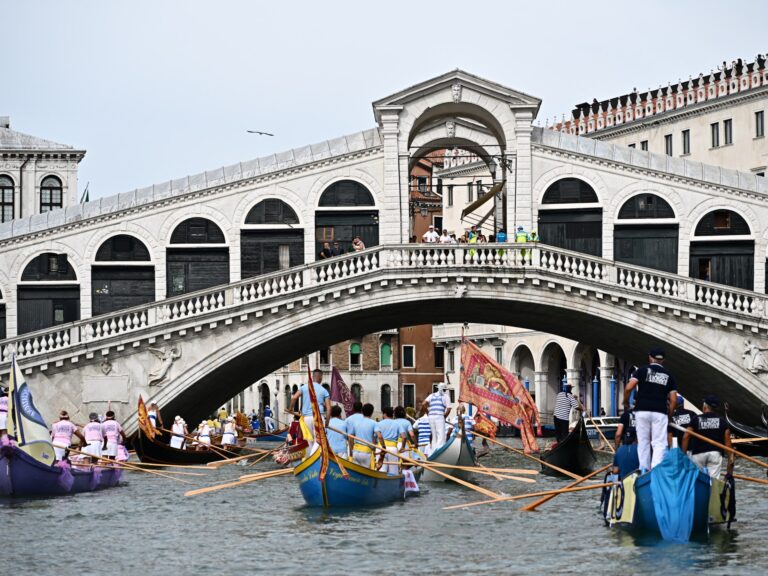Proposals are being considered to double entrance fees at the famous Italian tourist destination for next year.
Venice has ended an experimental program that charged day-trippers a 5-euro ($5.46) entrance fee on particularly busy days, in a move critics called a failure.
Authorities in Italy’s famous tourist destination, which is also a UNESCO World Heritage Site, introduced an entrance tax in April in the hope of deterring some people from visiting. The system was designed to manage tourist flows during peak visitor numbers.
But on Saturday, dozens of activists gathered outside Santa Lucia station, overlooking the busy canal, to protest against the introduction of the entrance fee, which they argued would do little to deter tourists from visiting during peak hours as originally intended.
“This election is a failure, as the city’s data makes clear,” said opposition city council member Giovanni Andrea Martini.
Over the first 11 days of the trial period, the city saw an average of 75,000 tourists visit — 10,000 more per day than over the three major holidays in 2023, Martini said, citing figures provided by the city based on cellphone data that tracks visitors to the city.
 Gondolas sail along Venice’s historic Grand Canal [File: Luigi Costantini/AP]Simone Venturini, the city council member in charge of tourism and social integration, said initial evaluations of the program were positive and confirmed the system would be updated in 2025, but acknowledged that it would still attract large crowds.
Gondolas sail along Venice’s historic Grand Canal [File: Luigi Costantini/AP]Simone Venturini, the city council member in charge of tourism and social integration, said initial evaluations of the program were positive and confirmed the system would be updated in 2025, but acknowledged that it would still attract large crowds.
“Some weekends were less crowded than this time last year, but no one expected that all the day-trippers would miraculously disappear,” he told Reuters.
“In future, if we add more days and increase the fees, it will be more effective,” he added, without saying how much tourists would have to pay in 2025.
A city spokesman added that a proposal was being considered to double the fee to 10 euros ($10.92) next year.
“Turning Venice into a museum”
Some 438,000 tourists paid the tax in the past two and a half months, generating revenue of about 2.19 million euros ($2.4 million), the Associated Press reported, citing data provided by the city.
The tax will not apply to people staying in Venice hotels, who are already subject to the occupancy tax, and exemptions also apply to children under 14, local residents, students, workers and people visiting relatives.
Officials say the money will go towards essential services like trash removal and maintenance, which are costly in the cities the canal passes through.
Opponents of the plan want policies such as limits on short-term rentals to encourage residents to move back to Venice’s historic center, which has seen decades of migration from the city to more convenient areas on the mainland.
“this [entrance fee] “Reducing it to 10 euros is a total waste. It will turn Venice into a museum,” Martini said.
 Exterior of the Doge’s Palace in Venice, northern Italy [File: Domenico Stinellis/AP]Many of the banners at Saturday’s protest also expressed growing concern about the electronic and video surveillance system the city installed in 2020 that is the backbone of its tourism management system and monitors the mobile phone data of people visiting the city. The placards included warnings about the use of personal data and a lack of data privacy.
Exterior of the Doge’s Palace in Venice, northern Italy [File: Domenico Stinellis/AP]Many of the banners at Saturday’s protest also expressed growing concern about the electronic and video surveillance system the city installed in 2020 that is the backbone of its tourism management system and monitors the mobile phone data of people visiting the city. The placards included warnings about the use of personal data and a lack of data privacy.
“The ticket is a big obstacle for the media. They only talk about this 5 euros, which will become 10 euros next year,” said Giovanni Di Vito, a Venice resident who has been active in the anti-tourist tax movement.
“But no one is paying attention to the system of surveillance and control of the population.”
To stop low-income families being put off by high prices, Martini instead advocated a system of free reservation of visitor slots, which would make it possible to track expected tourist arrivals.
“We need to be able to warn people that if they come on certain days they’re not going to have a good time,” he said, adding that the long-term goal is to bring back full-time residents who have fled the city in recent years as short-term rentals have become increasingly mainstream in the housing market.

